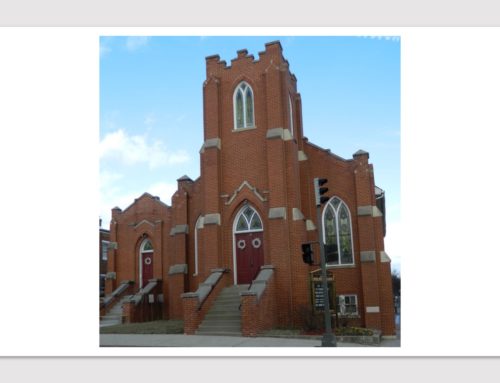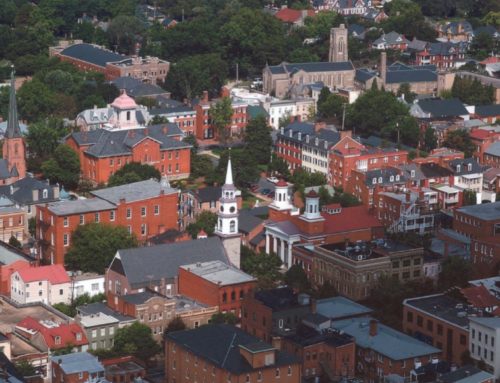Excerpt from Frederick News-Post:
Developers and architects working on Frederick’s proposed downtown hotel and conference center promised this week that historic preservation was a key element in developing project plans over the past several years.
A group of historic preservation activists are not so convinced, though, and urged members of the city’s Historic Preservation Commission at a workshop Thursday to seriously consider the repercussions of constructing the planned 180-room hotel and 20,000-square-foot conference center in the heart of the Frederick Town Historic District.
“I want you to hold this project, not the individual person but this project, to the fire,” former Historic Preservation Commission Chairman Scott Winnette said to commissioners at the workshop. “Just hold it to the fire, they can figure out how to make it work.”
The project is planned for 200-212 E. Patrick St. along Carroll Creek, the site of the historic Birely Tannery and the former Frederick News-Post building, which was once the historic Frederick trolley station. The commission is tasked to view project plans and decide how to best preserve the historic elements of the site as it moves forward.
Winnette, who spent 10 years on the other side of the dais, said he believes city officials made a mistake when they issued a request for proposal for the project at that site several years ago. He urged the historic preservation commissioners to preserve not only the historic elements of the tannery site, which date back to the 1860s when tanning was the biggest industry in the city, but also save the early 20th-century brick building now slated for demolition.
The commission voted July 13 to designate the tannery building and surrounding archaeological site as a contributing resource of unusual importance to the district. The vote held off a request to demolish the building to give commissioners time to review the plans and determine how to best preserve the historic elements of the site.
The commission’s guidelines “generally discourage” demolition of historic structures. The guidelines state that the commissioners will consider demolition only when all possible alternatives have been exhausted. The architects and developers maintain that this has been done and it is up to the commissioners to determine whether that is true.
Thursday’s workshop was the second one the commissioners held and will not be the last.
Pete Plamondon Jr., co-president of developers Plamondon Hospitality Partners, said he expects at least two more workshops to discuss the project before the commissioners are ready to vote. He said the timeline for the project is at the mercy of the commission, as it must be approved at that level to move forward.
Winnette’s comments Thursday, and similar comments from several other members of the public who are interested in preserving the city’s historic elements, followed a lengthy presentation from architect Peter Fillat and Plamondon regarding the latest project plans.
The plans tentatively propose to demolish the tannery building and restore the trolley building for retail space. In the presentation, Fillat and Plamondon walked the commissioners through the steps they took to decide the tannery building was not worth saving at its current location and why they believe the trolley building is worth rehabilitation.
Reaching the decision, they said, was a long and arduous process, and they did not come to it easily.
Plamondon explained that the tannery building’s odd shape, small size and location an entire level below Carroll Creek make it an undesirable candidate for rehabilitation at its current spot.
The condition of the building also leaves a lot to be desired, Fillet added.
“It’s above average in terms of scary,” he said, referring to the building’s run-down state.
Fillat also pointed out that many of the historic elements of the building are no longer there, citing several fires that happened over the years that ruined various parts of it.
Winnette and others who commented Thursday and during other elements of the process disagree, though. Several project opponents have said the tannery building is the last piece of history the city has that pays homage to the tanning industry and its importance to the area. The building has been classified as the last tanning facility in Maryland. A report from the Maryland Historical Trust also designated the building and archaeological site as candidates for the National Register of Historic Places, thus giving it further historic significance, according to some of the commenters.
Plamondon also explained how the brick trolley building was instead chosen for rehabilitation. He said the structure is in a much better location on Patrick Street and in better condition.
“It was a pretty easy decision on our part to say that’s the building to restore,” Plamondon said. “Because of the prominence, site and condition, maybe most importantly.”
Plamondon also responded to allegations that the architects and developers have not considered the historic elements of the tannery and the site as a whole when developing the project plans over the past several years.
“The tannery business along Carroll Creek has always been first and foremost,” he said. “We are not one to disrespect or ignore the history of Frederick, I assure you.”
At the next workshop, the architects and developers are set to present more details of the efforts made to try to incorporate the tannery building into the project plans and why they will not work.



